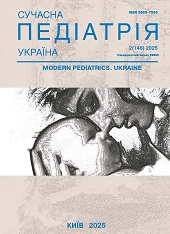The effectiveness of montelukast in the complex treatment of children with seasonal allergic rhinitis caused by sensitization to ragweed and wormwood allergens
DOI:
https://doi.org/10.15574/SP.2025.2(146).712Keywords:
seasonal allergic rhinitis, bronchial asthma, pollenosis, hay fever, children, montelukast, food allergy, urticaria, oral allergic syndrome, Art v 3, LTP proteins, cross-sensitization, molecular allergologyAbstract
Seasonal persistent allergic rhinitis (AR) is an urgent problem of paediatrics, and its prevalence among the population of European countries is about 16%, increasing every year. Among the allergens that have a significant impact on the development of seasonal AR, sensitization to ragweed and ragweed allergens is of great importance. Basic pharmacotherapy of AR in such patients does not always allow for full control of allergy manifestations, which necessitates the search for adjuvant agents to control AR.
Aim - to evaluate the efficacy of montelukast in children with persistent seasonal AR in case of sensitization to ragweed and wormwood allergens.
Materials and methods. Clinical, anamnestic and laboratory examination of 62 children aged 6 to 12 years with AR and sensitization to ragweed and wormwood was performed in 2023 and 2024. In both years of follow-up, patients received basic therapy according to ARIA recommendations (2022). Montelukast (Glemont), at a dosage of 5 mg daily, was prescribed only in 2024 to patients with the first symptoms of AR.
Results. The duration of clinical manifestations of AR during exacerbations was significantly shorter in patients treated with montelukast. In the examined patients, ‘molecular spreading’ of allergy was observed. When montelukast was used among the patients studied in 2024, complaints of coughing and nasal congestion were significantly less frequent. In patients treated with montelukast, an increase in the level of nitric oxide in the exhaled air (Fraction of exhaled nitric oxide - FeNO) was significantly less frequent.
Conclusions. The addition of montelukast (Glemont) to the treatment regimen for seasonal persistent AR contributes to a significant reduction in the duration of exacerbations by 1.6 times and improves the clinical course of AR. The use of montelukast in the treatment regimen for seasonal AR helps to reduce FeNO levels.
The study was conducted in accordance with the principles of the Declaration of Helsinki. The study protocol was approved by the Local Ethics Committee (LEC) for all participants. Informed consent was obtained from patients (parents of children or their guardians).
There was no conflict of interest.
References
Akmatov MK, Holstiege J, Dammertz L, Heuer J, Kohring C, Bätzing J. (2022). Secular Trends and Rural-Urban Differences in Diagnostic Prevalence of Hay Fever: A Claims-Based Study in Germany. J Asthma Allergy. 15: 1205-1215. https://doi.org/10.2147/JAA.S371791; PMid:36068864; PMCid:PMC9441166
Bousquet J, Toumi M, Sousa-Pinto B, Anto JM, Bedbrook A, Czarlewski W et al. (2022, Nov). The Allergic Rhinitis and Its Impact on Asthma (ARIA) Approach of Value-Added Medicines: As-Needed Treatment in Allergic Rhinitis. J Allergy Clin Immunol Pract. 10(11): 2878-2888. Epub 2022 Aug 4. https://doi.org/10.1016/j.jaip.2022.07.020; PMid:35934308
Dramburg S, Hilger C, Santos AF, de Las Vecillas L, Aalberse RC, Acevedo N et al. (2023, Mar). EAACI Molecular Allergology User's Guide 2.0. Pediatr Allergy Immunol. 34; Suppl 28: e13854. https://doi.org/10.1111/pai.13854; PMid:37186333
Dramburg S, Matricardi PM. (2019, Sep 24). Molecular Diagnosis of Allergy: The Pediatric Perspective. Front Pediatr. 7: 369. PMID: 31616646; PMCID: PMC6768979. https://doi.org/10.3389/fped.2019.00369
Esmail DH, Ashour ZA, Sheha DS, Mohamed NA, AbdAllah AM et al. (2022, Oct). Frequency of ragweed sensitization and allergy among patients with respiratory allergy. Egypt J Immunol. 29(4): 115-124. https://doi.org/10.55133/eji.290411; PMid:36206154
GINA. (2024). Global Strategy for Asthma Management and Prevention. URL: https://ginasthma.org/2024-report/.
Marushko YuV, Halushko BL. (2023). Clinical characteristics of children with persistent allergic rhinitis and bronchial asthma sensitised to different molecules of house dust mite allergens. Modern Pediatrics. Ukraine. 7(135): 52-59. https://doi.org/10.15574/SP.2023.135.52
Marushko YuV, Moskovenko OD, Halushko BL. (2021). Cetirizine is an effective and safe antihistamine (literature review, results of clinical researches). Modern Pediatrics. Ukraine. 8(120): 55-61. https://doi.org/10.15574/SP.2021.120.55
Mayoral K, Lizano-Barrantes C, Zamora V, Pont A, Miret C, Barrufet C et al. (2023, Oct 18). Montelukast in paediatric asthma and allergic rhinitis: a systematic review and meta-analysis. Eur Respir Rev. 32(170): 230124. https://doi.org/10.1183/16000617.0124-2023; PMid:37852659 PMCid:PMC10582929
Montagnani C, Gentili R, Citterio S. (2023). Ragweed is in the Air: Ambrosia L. (Asteraceae) and Pollen Allergens in a Changing World. Curr Protein Pept Sci. 24(1): 98-111. https://doi.org/10.2174/1389203724666221121163327; PMid:36411556
Mortimer K, Lesosky M, García-Marcos L, Asher MI, Pearce N, Ellwood E et al. (2022, Sep 15). The burden of asthma, hay fever and eczema in adults in 17 countries: GAN Phase I study. Eur Respir J. 60(3): 2102865. https://doi.org/10.1183/13993003.02865-2021; PMid:35210319 PMCid:PMC9474894
Muluk NB, Cingi C. (2018, Jan 1). Oral allergy syndrome. Am J Rhinol Allergy. 32(1): 27-30. https://doi.org/10.2500/ajra.2018.32.4489; PMid:29336286
Muntean IA, Bocsan IC, Vesa S, Miron N, Nedelea I et al. (2020, May 14). Could FeNO Predict Asthma in Patients with House Dust Mites Allergic Rhinitis? Medicina (Kaunas). 56(5): 235. https://doi.org/10.3390/medicina56050235; PMid:32422966 PMCid:PMC7279291
Downloads
Published
Issue
Section
License
Copyright (c) 2025 Modern pediatrics. Ukraine

This work is licensed under a Creative Commons Attribution-NonCommercial 4.0 International License.
The policy of the Journal “MODERN PEDIATRICS. UKRAINE” is compatible with the vast majority of funders' of open access and self-archiving policies. The journal provides immediate open access route being convinced that everyone – not only scientists - can benefit from research results, and publishes articles exclusively under open access distribution, with a Creative Commons Attribution-Noncommercial 4.0 international license (СС BY-NC).
Authors transfer the copyright to the Journal “MODERN PEDIATRICS. UKRAINE” when the manuscript is accepted for publication. Authors declare that this manuscript has not been published nor is under simultaneous consideration for publication elsewhere. After publication, the articles become freely available on-line to the public.
Readers have the right to use, distribute, and reproduce articles in any medium, provided the articles and the journal are properly cited.
The use of published materials for commercial purposes is strongly prohibited.

